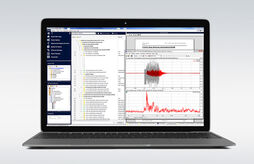ACOPTs – ACQUA options for extended functionality of the analysis software

A variety of ACQUA options, so-called ACOPTs, allow individual tailoring of the software performance to specific user requirements. Including:
- Tools for signal generation and analysis
- Special calculation methods for psychoacoustics
- Various methods for instrumental evaluation of speech quality using Mean Opinion Score (MOS) values
- Options for clear result presentation like quality pie charts
ACOPT 01 (Signal Generator and Editor)
Code 6811
This ACQUA option allows comfortably generating and editing of almost any signals. Features of ACOPT 01:
- Signal generator for following basis signals: Sine, square, triangle, sweep, stepped sweep, white and pink noise, pseudo noise for different FFT lengths, Fourier generator
- Generate signals according to mathematical formulas
- Signal editor for processing time signals, e.g. speech signals
- Automatically process signals in a very powerful batch mode
- Level adjustment of signals also on the basis of the optional (see ACOPT 09) speech level (active speech level)
- Copy signal parts across any number of channels
- All effects of changes to time signals are immediately displayed in the spectrum
ACOPT 02 (Signal Analysis)
Code 6812
ACOPT 02 enables users to switch to another analysis of the recorded signal after conducting a measurement and post-analyze it. Without this ACQUA option, for post-analysis it is only possible to change the parameters of the applied analysis.
ACOPT 09 (SLVM P.56)
Code 6819
ACOPT 09 the speech level voltmeter (SLVM) complies with the international standard ITU-T P.56 (method B). This ACQUA option allows calculation of the ASL value (active speech level).
ACOPT 10 (TOSQA)
Code 6820
This ACQUA option enables determination of speech quality according to TOSQA method (Telecommunications Objective Speech Quality Assessment). ACOPT 10 provides a MOS value as well as an impairment factor.
ACOPT 11 (CLIP)
Code 6821
ACOPT 11 is the ACQUA option to output user-definable CLIP data according to the European standard ETS 300 778-1. Features of ACOPT 11:
- Support of all three activation methods: Dual Tone Alerting Signal (DT-AS), Line reversal followed by DT-AS, Ringing Pulse Alerting Signal
- Free choice of transferable data
- Free choice of all signalization frequencies and levels
ACOPT 12 (DTMF)
Code 6822
ACOPT 12 allows users to analyze dual-tone multi-frequency (DTMF) signals according to ETSI standard TBR 21. Features of this ACQUA option:
- Output of all recognized signals
- Check of following parameters:
- min./max. level of high/low frequency
- min./max. level difference
- min. signal-to-noise ratio
- max. frequency deviation
- min./max. dial/pause time
- max. rise/fall time
ACOPT 16 (PESQ)
Code 6836
ACOPT 16 is the ACQUA option for determination of MOS values according to PESQ (Perceptual Evaluation of Speech Quality). It provides an advanced quality measure to determine perceived speech quality in telecommunication according to recommendation ITU-T P.862.
ACOPT 17 (Relative Approach)
Code 6839
ACOPT 17 allows the Relative Approach analysis - a psychoacoustic method developed by HEAD acoustics based on a hearing model. It enables users to display graphically audible structures in signals in the time and frequency domain that are hardly noticeable on other analyses.
ACOPT 18 (Remote Control ACQUA via COM Interface)
Code 6840
ACOPT 18 is the ACQUA option for external control of automated measurement sequences. Features are:
- List and select prepared ACQUA projects via the COM interface and start these projects completely or in parts
- Data storage: select existing ACQUA measurement objects or create new ones together with their descriptors
- Feedback on the progress of the measurement sequence and the measurement results via COM events
- Generate ACQUA reports for selected measurement object
ACOPT 19 (Online Analysis)
Code 6842
This ACQUA option provides the functions of Online FFT and Online Distortion. During these two real-time analyses, users can simultaneously play back continuous excitation signals. The analyses can be parameterized as far as possible, e.g. the resolution of the spectral analysis as well as the type of distortion calculation can be selected. Special distortion calculation methods like "Rub & Buzz" and “Total Distortion” according to recommendation ITU O.132 can also be used. The time constants of the analyses is selectable in such a way that the effects of changes in the measurement chain (e.g. compression force-dependent transfer functions between the handset and the artificial ear, etc.) are evaluable interactively and directly.
ACOPT 20 (Quality Pie)
Code 6843
ACOPT 20 enables a very clear presentation of even complex measurement results in the form of pie diagrams according to recommendation ITU-T P.505. These so-called One View Visualizations diagrams allow to compare and to evaluate multidimensional results of different measurement objects at a glance. Pre-defined templates with all parameter settings and limit values are available for numerous test scenarios (e.g. IP telephony, gateways, mobile phones, hands-free terminals). It is possible to generate and to save own templates for individual test evaluations.
ACOPT 21 (3QUEST)
Code 6844
The ACQUA option 3QUEST (3-fold Quality Evaluation of Speech in Telecommunications) provides a calculation method which allows the instrumental speech quality evaluation of telecommunication terminals in the presence of noise. 3QUEST is based on the ETSI standards EG 202 396-3 and TS 103 106 covering both narrowband and wideband scenarios including background noise. For super-wideband and fullband scenarios, ACOPT 35 is available.
ACOPT 23 (GCF)
Code 6848
The Global Certification Forum (GCF) defines test criteria for certification of 2G, 3G and 4G mobile equipment. As a member of GCF, HEAD acoustics offers the GCF-approved test platforms TP 89, TP 90 and TP 190, which cover audio test cases for narrowband, wideband and super-wideband scenarios according to 3GPP standards TS 26.131, TS 26.132 and TS 51.010-1.
In combination with TP 89, TP 90 or TP 190, ACOPT 23 enables manufacturers and test laboratories to submit test cases of 2G, 3G and 4G mobile equipment validated on any of these three test platforms the Global Certification Forum for official GCF approval.
ACOPT 24 (PTCRB)
Code 6849
The PCS Type Certification Review Board (PTCRB) defines test criteria for certification of 2G, 3G and 4G mobile equipment. HEAD acoustics offers the PTCRB-approved test platforms TP 89, TP 90 and TP190, which cover audio test cases for narrowband, wideband and super-wideband scenarios according to 3GPP TS 26.131, TS 26.132 and TS 51.010-1.
In combination with TP 89, TP 90 or TP 190, ACOPT 24 enables manufacturers and test laboratories to submit test cases of 2G, 3G and 4G mobile equipment validated on any of these three test platforms the PCS Type Certification Review Board for official PTCRB approval.
ACOPT 25 (Psychoacoustics)
Code 6852
ACOPT 25 provides a measurement descriptor, which allows conducting various psychoacoustic analyses (also selectable from the ACQUAlyzer menu Analysis). The ACQUA option provides the following analysis methods, among others:
- Loudness vs. Time (ISO 532-1 and others)
- Specific Loudness (ISO 532-1 and others)
- Specific Loudness vs. Time (ISO 532-1 and others)
- Sharpness vs. Time
- Roughness vs. Time (Hearing Model)
- Specific Roughness (Hearing Model)
- Specific Roughness vs. Time (Hearing Model)
ACOPT 26 (Room Acoustics)
Code 6853
ACOPT 26 offers a measurement descriptor for conducting room acoustics measurements based on maximum length sequence signals (also selectable from the ACQUAlyzer menu Analysis). In addition to the impulse response, this ACQUA option allows calculation of the reverberation time (RT60, EDT), the reverberation time over frequency bands and the cumulative decay spectrum.
ACOPT 27 (Speech Transmission Index (STITEL, STIPA, RASTI))
Code 6854
This ACQUA option offers a measurement descriptor for calculation of the speech transmission index variants STITEL, STIPA, RASTI (also selectable from the ACQUAlyzer menu Analysis) according to IEC 60628-16.
ACOPT 28 (SNRI & TNLR Calculation According to ITU-T G.160)
Code 6855
ACOPT 28 provides a measurement descriptor for conducting measurements for calculation of values according to ITU-T G.160 (Appendix II, Amendment 2, 08/2011). Moreover, this ACQUA option provides a new menu item in the ACQUAlyzer Calculation menu for applying this calculation method to the signal currently displayed in the time window.
ACOPT 29 (EQUEST)
Code 6856
ACOPT 29 provides a calculation method developed by HEAD acoustics for assessing the echo performance of terminals based on the hearing model analysis EQUEST (Echo Quality Evaluation of Speech in Telecommunications). EQUEST enables users to evaluate narrowband, wideband and super-wideband scenarios. In particular, masking effects that are neglected by other established methods are also taken into account in this process.
ACOPT 30 (POLQA)
Code 6857
This ACQUA option offers a calculation method for determining MOS values according to POLQA (Perceptual Objective Listening Quality Analysis).
POLQA is a voice quality testing technology for fixed, mobile and IP-based networks. It was standardized by ITU-T as recommendation P.863, and can be applied e.g. for speech quality analysis of HD Voice, HD Voice+, 3G and 4G/LTE networks.
ACOPT 31 (Batch Processing)
Code 6858
ACOPT 31 provides a stand-alone tool for automatic batch calculation of PESQ, TOSQA, 3QUEST, 3QUEST-SWB/FB, POLQA, G.160 (SNRI), EQUEST, Speech-based Double-Talk, and AutoDT (Automated Double Talk Analysis). Except for the latter, the respective ACOPTs are required in addition.
ACOPT 32 (Speech-based Double Talk)
Code 6859
ACOPT 32 provides two speech-based methods for measuring and analyzing double talk, primarily to evaluate the performance of echo cancellation:
- Automated double talk analysis with speech signals according to recommendation ITU-T P.502
- Speech-based double talk analysis according to 3GPP standard TS 26.132
ACOPT 34 (Speech Intelligibility Index)
Code 6865
The SII is a measure for speech intelligibility in situations with background noise. ACOPT 34 (option Speech Intelligibility Index (SII)) calculates the speech intelligibility index of a combination of a noise and a speech signal according to ANSI S3.5-1997. The speech signal is specified spectrally. Users can use a special speech spectrum according to ANSI S3.5 or their own.
ACOPT 35 (3QUEST-SWB/FB)
Code 6866
As advancement of 3QUEST (ACOPT 21), ACOPT 35 (option 3QUEST-SWB/FB) implements the standardized methods according to ETSI TS 103 281 (Model A) for calculation of S-MOS (Speech Quality), N-MOS (Noise Influence) and G-MOS (Overall Quality) for super-wideband and fullband scenarios (frequency range up to 20 kHz).
Due to a very complex training and validation process, the calculation method is even more robust against signal processing procedures and background noise that were not available in the training databases. 3QUEST-SWB/FB no longer requires an unprocessed reference signal.
ACOPT 36 (MDAQS)
Code 6867
MDAQS is an AI-based method developed by HEAD acoustics for instrumental evaluation of audio quality. The method is based on an algorithm trained with test results from a tailor-made auditory test design. MDAQS calculates MOS values for four key criteria for audio quality as perceived by naïve listeners of arbitrary playback systems and devices such as loudspeakers, headphones, headsets, in-vehicle audio systems, mobile and smart speakers. This allows quick and convenient assessment of audio playback quality during and after development.
ACOPT 37 (ABLE/Listening Effort)
Code 6869
ABLE (Assessment of Binaural Listening Effort) extends ACQUA with the capability to assess the effort for perceiving speech signals from communication devices automatically and reproducibly. For simulation of realistic scenarios, the speech signals are impaired by a background noise simulation system. The analysis and the assessment process of ABLE follow the specifications according to ETSI TS 103 558. The results of the assessment are presented as plain MOS (Mean Opinion Score) value.








